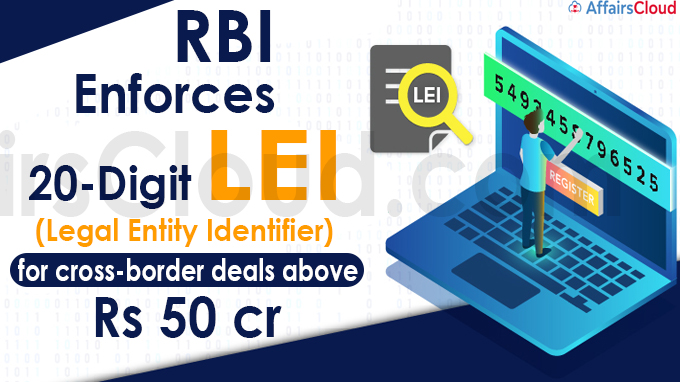
In December 2021, the Reserve Bank of India (RBI) has mandated the companies to quote the 20-digit Legal Entity Identifier (LEI) for cross-border transactions for capital or current account transactions of Rs 50 crore and above, from October 1 2022.
What is LEI and who maintains it?
i.LEI is a number used to uniquely identify parties to financial transactions worldwide to improve the quality and accuracy of financial data systems.
ii.The LEI numbers are maintained in a global LEI database available on the website of the Global Legal Entity Identifier Foundation (GLEIF).
iii.RBI has introduced the LEI in a phased manner for over the counter (OTC) derivative, non-derivative markets, large corporate borrowers and large value transactions in centralised payment systems.
Key Regulations of RBI:
i.AD (Authorised Dealers) Category-I banks were directed by RBI to obtain LEI numbers from local companies (resident entities) undertaking capital or current account transactions of Rs 50 crore and above, for each transaction.
- Those banks shall have the required systems in place to capture the LEI information and ensure that any LEI captured is validated against the global LEI database available on the website of the GLEIF.
ii.Once an entity has obtained an LEI number, it is mandatory for the firms to furnish the LEI number in all transactions of the entity irrespective of transaction size.
iii.Entities were also allowed to obtain LEI from any of the Local Operating Units (LOUs) accredited by the GLEIF, the body tasked to support the implementation and use of LEI.
- In India, LEI can be obtained from Legal Entity Identifier India Ltd. (LEIL). LEIL is also recognised as an issuer of LEI by the RBI under the Payment and Settlement Systems Act, 2007.
Note – The directions were issued by RBI under sections 10(4) and 11(1) of the Foreign Exchange Management Act (FEMA), 1999 (42 of 1999).
Recent Related News:
In August 2021, the Reserve Bank of India (RBI) introduced a scheme named ‘Scheme of Penalty for non- replenishment of ATMs’ to levy monetary charges/Penalty on Banks & White Label ATM Operators (WLAOs) for cash-out (i.e. the non-availability of cash) in Automated Teller Machines (ATMs) due to non-replenishment of cash.
About Reserve Bank of India (RBI):
Established – 1st April 1935
Headquarters– Mumbai, Maharashtra
Governor– Shaktikanta Das
Deputy Governors – Mahesh Kumar Jain, Michael Debabrata Patra, M. Rajeshwar Rao, T. Rabi Sankar




